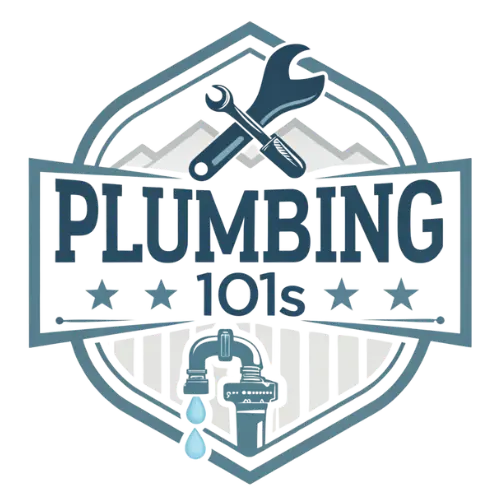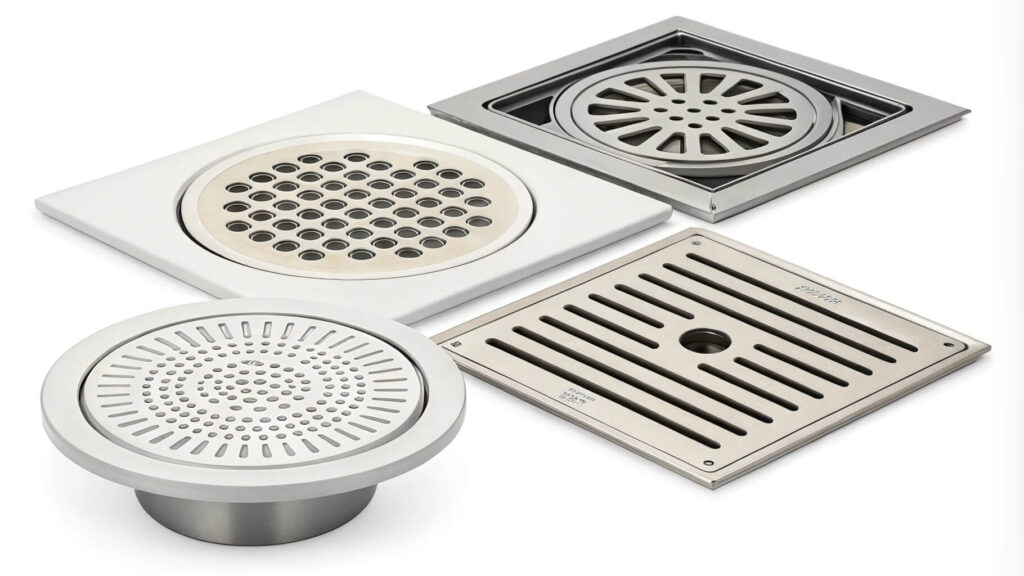Shower drains differ from standard household drains through specialized design features and enhanced water management capabilities. These drains handle high-volume water flow, typically processing 2.5-5 gallons per minute, while incorporating built-in strainer systems to capture hair and debris.
Their construction requires specific slope requirements (1/4 inch per foot minimum), thorough waterproofing systems, and corrosion-resistant materials like stainless steel to withstand constant moisture exposure.
Unlike standard drains, shower drains must integrate seamlessly with surrounding tile work and include multiple protective membrane layers to prevent water damage. Understanding these unique characteristics helps guarantee proper installation and maintenance of these essential bathroom components.
Highlights
- Shower drains require specialized strainer systems to handle hair and debris while maintaining higher flow rates of up to 5 gallons per minute.
- Complex waterproofing systems with multiple membrane layers and critical joint protection are essential, unlike standard household drains.
- Specific slope requirements of 1/4 inch per foot are mandatory for proper water evacuation in shower installations.
- Integration with tile and modern aesthetics demands specialized designs like tile-in drains and linear drainage options.
- Shower drains must handle continuous multi-stream water flow and require corrosion-resistant materials due to constant moisture exposure.
Specialized Design Features
Shower drains represent a marvel of specialized engineering, featuring distinct design elements that set them apart from standard household drains. These purpose-built fixtures incorporate multiple innovative features that address the unique challenges of managing high-volume water flow in shower environments.
The specialized designs of shower drains focus primarily on three critical components:
- Strainer Systems: Built-in strainers effectively capture hair and debris while maintaining efficient drainage, preventing potential blockages that could compromise water flow.
- Slope Integration: Many modern shower drains, particularly linear varieties, work in conjunction with precisely angled floor surfaces to enhance water movement toward the drain opening.
- Material Construction: Manufacturers utilize corrosion-resistant materials, such as high-grade stainless steel, to guarantee long-term durability against constant moisture exposure and cleaning chemicals.
Advanced options like tile-in drains demonstrate the evolution of shower drain technology, allowing for seamless integration with surrounding floor materials.
These sophisticated designs maintain peak drainage efficiency while providing aesthetically pleasing solutions that blend naturally with modern bathroom designs. The combination of functional engineering and architectural considerations results in drainage systems specifically tailored to shower environments’ demands.
Water Volume Management
Shower drains demonstrate exceptional water volume management through their ability to process high-speed water evacuation, often handling flow rates of up to 5 gallons per minute from modern showerheads.
The drain’s design incorporates multi-stream flow management features, including strategically placed channels and slope gradients, which direct water efficiently toward the main drainage point.
The relationship between drain capacity and drainage rate is vital, as the drain must maintain consistent water removal that matches or exceeds the incoming water volume to prevent flooding and guarantee safe shower conditions.
High-Speed Water Evacuation
Modern drainage systems in showers excel at managing substantial water volumes, with standard installations processing more than 2.5 gallons per minute. The engineering behind shower drains incorporates specialized features that enable high-speed water evacuation through gravity-driven mechanisms and strategic slope designs.
Key Features of High-Speed Water Evacuation:
| Component | Function | Benefit |
|---|---|---|
| Linear Drains | Large surface area coverage | Enhanced water collection |
| Slope Design | Gravitational assistance | Prevents water pooling |
| Strainer Systems | Debris filtration | Maintains flow efficiency |
Proper drainage depends on multiple factors working in harmony to achieve ideal water flow. The integration of strainers and traps prevents clogging while maintaining consistent evacuation speeds, which is vital for preventing bathroom flooding. Regular maintenance guarantees these systems continue operating at peak efficiency.
Technical Considerations:
- Minimum slope requirement of 1/4 inch per foot
- Strategic placement of drain channels
- Implementation of venting systems
- Regular cleaning to prevent buildup
- Professional inspection of seals and connections
These design elements work together to create a robust drainage system capable of handling high-volume water flow while maintaining sanitary conditions.
Multi-Stream Flow Management
Advanced flow-management systems distinguish shower drainage from conventional plumbing through their ability to handle multiple water streams simultaneously. Shower drains incorporate specialized features that efficiently process water discharge rates exceeding 2.5 gallons per minute, making them uniquely suited for multi-stream flow management.
Key Design Elements:
- Strategic placement of strainers and traps to prevent blockages while maintaining ideal flow
- Gravity-driven flow dynamics that accelerate water movement through the drainage system
- Carefully engineered shower floor slopes that direct water from multiple angles toward the drain
The effectiveness of multi-stream management depends on two primary factors:
- Drain Configuration:
- Linear drains provide extended coverage for capturing water across wider areas
- Point drains utilize centralized collection points with enhanced capacity
- Water Distribution Control:
- Sloped surfaces guide multiple water streams toward drainage solutions
- Integrated channels guarantee effective water drainage from all shower areas
These design elements work together to create a thorough system that efficiently manages varying water volumes while preventing flooding and maintaining proper drainage performance under demanding conditions.
Capacity vs. Drainage Rate
Understanding the relationship between capacity and drainage rate is essential for effective shower water management. Modern shower drains demonstrate sophisticated engineering that balances water intake volume with discharge capabilities, particularly in their design specifications and installation requirements.
The correlation between capacity and drainage rate manifests in two key areas:
- Design Configuration
- Linear drains offer superior capacity, handling over 30 liters per minute.
- Point drains provide concentrated drainage in a smaller area.
- Slope requirements of 1-2% guarantee efficient drainage regardless of design.
- Performance Factors
- Strainer mesh size directly impacts water flow while preventing clogs.
- Installation quality affects overall drainage efficiency.
- Regular maintenance preserves ideal flow rates.
The relationship between these elements determines a shower drain’s effectiveness in managing water volume. Proper installation guarantees that capacity matches drainage rate requirements, preventing water pooling and maintaining efficient drainage throughout the system.
The choice between linear and point drains should consider both the expected water volume and the desired drainage rate, as these factors work together to create a properly functioning shower drainage system.
Installation and Slope Requirements
The successful installation of shower drains hinges on precise slope requirements and strategic placement within the shower area. Unlike standard household drains, shower drains demand a specific gradient, or downward angle, of 1/4 inch per foot to guarantee proper drainage and prevent water accumulation.
Installation complexity varies based on drain type:
- Traditional Point Drains: Require multiple-direction slopes converging at a central point
- Linear Drains: Allow for simplified single-direction slopes, making installation more straightforward
Critical installation requirements include:
- Precise placement at the shower floor’s lowest point
- Professional-grade waterproofing to prevent structural damage
- Compliance with local plumbing codes
- Proper sealing around drain components
Complex installation procedures often necessitate professional expertise, particularly for specialized designs like tile-in or linear drains.
The waterproofing process involves multiple layers of protective materials, including membranes and sealants, to create a watertight barrier.
This systematic approach guarantees long-term functionality and prevents water infiltration into surrounding building materials, making shower drains distinctly different from standard household drainage systems.
Waterproofing Considerations
Proper waterproofing of shower drains begins with the application of membrane systems, which create a continuous waterproof barrier between the drain assembly and surrounding floor materials.
Critical joint protection, including careful sealing of corners and connections, serves as a fundamental defense against water infiltration through vulnerable connection points.
The installation of barrier layers, comprising both primary and secondary waterproofing materials, must be precisely coordinated with the drain flange to establish a complete and reliable moisture-blocking system.
Membrane System Applications
Effective shower waterproofing relies heavily on membrane system applications that create an impermeable barrier between the shower area and the underlying structure. The membrane waterproofing system consists of a continuous waterproof layer that extends from the shower floor to the drain assembly, forming a complete seal against moisture penetration.
When installing shower drains with membrane systems, proper installation techniques are essential for long-term performance. The waterproof layer must be carefully integrated with the drainage components, guaranteeing no gaps or weak points exist where water could potentially seep through.
Modern shower designs often incorporate linear drains, which provide enhanced compatibility with membrane systems due to their straight edges and simplified installation requirements.
Key Installation Considerations:
- The membrane must extend at least 6 inches up the shower walls
- All seams require proper overlapping and sealing
- Drain flanges must be properly bonded to the membrane
- Pre-slope underneath the membrane guarantees proper water drainage
- Corner sections need reinforced waterproofing
- Testing should be conducted before the final tile installation
Following these technical specifications helps prevent common issues like mold growth and structural water damage while guaranteeing peak system performance.
Critical Joint Protection
Critical joints surrounding shower drains demand meticulous waterproofing attention to prevent moisture infiltration and maintain structural integrity. The proper installation of waterproofing systems around these significant areas requires careful consideration of multiple factors, including membrane placement and sealing techniques. The slope of the shower floor plays an essential role in directing water flow and reducing pressure on vulnerable joints.
Essential elements for critical joint protection include:
- Installation of a continuous waterproof membrane that extends from the drain flange to the surrounding surfaces, creating an uninterrupted moisture barrier.
- Proper sealing of all connections between the drain body and waterproofing materials, using appropriate sealants and compression rings.
- Implementation of correct shower floor slope ratios (typically 1/4 inch per foot) to prevent water pooling around critical joints.
- Regular inspection and maintenance of joint seals to identify potential weaknesses before water damage occurs.
The effectiveness of joint protection depends heavily on the initial installation quality and ongoing maintenance.
Waterproofing measures must account for both vertical and horizontal joint interfaces, ensuring complete coverage of all potential entry points for moisture. This thorough approach helps prevent water damage and extends the shower system’s lifespan.
Barrier Layer Installation
A robust barrier layer installation serves as the foundation for shower drain waterproofing integrity. This essential component prevents water leakage and protects underlying structures from moisture damage, which can compromise the entire bathroom’s structural stability.
The barrier layer, constructed from specialized waterproof materials, creates an impermeable shield that safeguards against water infiltration.
Key Installation Requirements:
- Complete coverage across the shower floor and extending up walls
- Seamless integration with a proper slope towards the drain
- Thorough testing before final flooring installation
- Regular inspection schedule for maintaining integrity
The installation process demands precise attention to detail, particularly in areas where the barrier layer meets the drain assembly. Waterproof materials, such as membrane sheets or liquid-applied coatings, must be properly sealed at all joints and corners to guarantee complete protection.
The barrier’s effectiveness in preventing leaks relies heavily on proper slope implementation, typically achieved through a pre-sloped mortar bed or specialized shower base.
Maintenance Considerations:
- Annual inspection of seals and joints
- Immediate repair of any detected damage
- Documentation of installation methods for future reference
- Professional assessment of barrier integrity every 3-5 years
Drain Cover Options
Modern shower drain covers offer homeowners a diverse selection of styles, materials, and functionalities to complement their bathroom design. Traditional grates, commonly crafted from stainless steel, provide excellent durability and resistance against corrosion, making them ideal for long-term use.
The customization options available today range from simple patterns to elaborate designer styles, allowing homeowners to match their drain covers with existing bathroom aesthetics.
For enhanced functionality and maintenance accessibility, contemporary drain covers incorporate innovative features that simplify cleaning and prevent potential plumbing issues. Linear drains, which feature elongated covers, have gained popularity in modern bathroom designs, offering both practical drainage and a sophisticated appearance.
Key considerations when selecting shower drain covers include:
- Material durability – stainless steel and brass options provide superior longevity compared to plastic alternatives
- Maintenance requirements – removable designs facilitate regular cleaning and debris removal
- Style compatibility – choose between traditional grates, tile-in options, or designer patterns to match bathroom décor
- Functionality features – integrated debris baskets or mesh screens help prevent clogs and reduce maintenance frequency
Maintenance and Cleaning Needs
While selecting an appropriate drain cover sets the foundation for proper shower drainage, maintaining these fixtures requires consistent attention and care.
Shower drains, particularly linear and tile-in varieties, demand more frequent cleaning due to their specialized design features that can accumulate debris more readily than standard drains.
Regular maintenance involves several key components:
- Cleaning the strainer or debris basket every 2-3 weeks to guarantee effective drainage
- Removing and cleaning detachable components to access hard-to-reach areas
- Inspecting for early signs of clogs or reduced water flow
- Addressing soap scum buildup before it causes significant blockages
Material selection plays an essential role in maintenance requirements.
Stainless steel shower drains typically offer easier cleaning and superior longevity compared to plastic alternatives, which may require additional maintenance due to staining and discoloration over time.
Preventative Measures:
- Install quality drain covers to minimize debris accumulation
- Perform regular cleaning schedules based on usage frequency
- Use appropriate cleaning tools and solutions for specific drain materials
- Address minor issues promptly to prevent major maintenance problems
Following these maintenance protocols helps maintain peak drain performance and extends the fixture’s operational lifespan.
Safety and Building Code Compliance
Safety regulations and building codes establish strict requirements for shower drain installations, encompassing essential specifications for size, placement, and overall system design.
Shower drains must comply with local regulations that dictate minimum size and slope requirements to guarantee proper water evacuation and prevent hazardous conditions. The National Standard Plumbing Code provides extensive guidelines that emphasize the importance of efficient water flow and proper ventilation systems.
Key compliance requirements include:
- Installation of a trap in shower drains to block sewer gases from entering living spaces, maintaining air quality and safety standards.
- Implementation of specific slope gradients, typically 1/4 inch per foot, to facilitate proper drainage and prevent water accumulation.
- Integration of slip-resistant materials around drain areas, meeting safety standards for wet-surface conditions.
- Regular inspection and maintenance protocols to guarantee continued functionality and prevent health-related issues.
Professional installation must adhere to these requirements while considering local climate conditions and usage patterns.
Building inspectors regularly verify compliance with these standards, examining factors such as proper sealing, adequate venting, and appropriate sizing to guarantee long-term safety and functionality.
Material and Construction Differences
From basic design to advanced features, shower drains exhibit distinct material and construction characteristics that set them apart from standard drainage systems. The fundamental construction relies on corrosion-resistant materials, primarily stainless steel or brass, which provide essential durability against constant water exposure and moisture-rich environments.
Key Construction Features:
- Built-in trap systems that prevent sewer gases from entering bathrooms
- Integrated strainer or grate components for improved maintenance and debris collection
- Angled base design that promotes efficient water flow
- Customizable aesthetic options, including linear and tile-in variations
The material selection process for shower drains prioritizes longevity and functionality, incorporating elements that standard drains may not require. The construction includes specialized features like sloped bases, which facilitate proper water drainage and prevent standing water issues.
These drains also utilize advanced manufacturing techniques to guarantee seamless integration with waterproofing membranes and surrounding floor materials.
Maintenance Considerations:
- Removable components for easy cleaning
- Accessible trap designs for routine servicing
- Durable materials that resist corrosion and wear
- Standardized sizes for replacement parts availability
Space and Layout Requirements
Every shower drain installation demands precise space and layout considerations to confirm ideal functionality. Shower drains require specific space configurations that accommodate proper water flow and drainage mechanisms, particularly at the shower floor’s lowest point. The installation area must be carefully planned to confirm peak performance, with consideration given to both the drain type and overall shower dimensions.
- Slope Requirements: The shower floor must maintain a minimum 1% gradient (1/8 inch per foot) toward the drain to prevent water pooling and confirm efficient drainage.
- Linear Drain Placement: These drains typically require an extended installation area along walls or shower entrances, allowing for single-direction slopes.
- Point Drain Configuration: Traditional center drains need centralized positioning with slopes from all directions, affecting the overall floor design.
- Layout Flexibility: Drain type selection influences shower space utilization, with linear drains often permitting more open designs than point drains.
The successful integration of shower drainage systems depends heavily on proper space planning, accurate measurements, and careful consideration of water flow patterns.
This technical approach confirms long-term functionality and prevents common drainage issues that could arise from improper installation.
Frequently Asked Questions
What Are the Different Types of Shower Drains?
Traditional shower drains include floor-mounted designs with removable strainers and clamping rings, wall-mounted drains for modern installations, and adjustable height drains that accommodate various flooring thicknesses and installation requirements.
How Are Shower Drains Designed?
Shower drains are engineered with specific drain materials and flow rate calculations, incorporating strainers for clog prevention. The installation process includes proper sloping, while design aesthetics guarantee both functionality and visual appeal.
What Are the Disadvantages of a Linear Shower Drain?
Linear shower drains present notable disadvantages including higher maintenance requirements, increased clogging issues, complex installation challenges, limited design aesthetics, potential water flow problems, and elevated cost factors compared to traditional drain systems.
Is There a Difference Between a Tub Drain and a Shower Drain?
Yes, tub drains and shower drains differ considerably in their functions, installation requirements, and plumbing codes. Tub drains require overflow mechanisms and stoppers, while shower drains focus on efficient water drainage and simpler maintenance needs.



